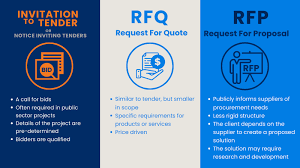
RFI, RFQ, & RFP: What’s the Difference?
RFP
An RFP, “Request for Proposal,” is a document that asks vendors to propose solutions to a customer’s problems or business requirements. An RFP is usually what follows an RFI; in fact, it’s rare that a company will go from an RFI to an RFQ (for reasons that will become clear below). An RFP should contain much more specificity in terms of what a company’s needs are by outlining the business goals for the project and identifying specific requirements that are necessary for the work being requested. The key to this document is that there is sufficient detail to give vendors the context they need in order to propose a valid solution, yet it still needs to allow enough leeway for the vendors to apply creativity and best practices to fulfill those needs.
RFQ
Short for “request for quotation,” the RFQ is an even more detailed document that drills down to the exact specifications required by the company. In a situation where an RFQ is used for a B2B software project, the company knows enough about its current system and exactly how it wants to change or improve it in the future.
